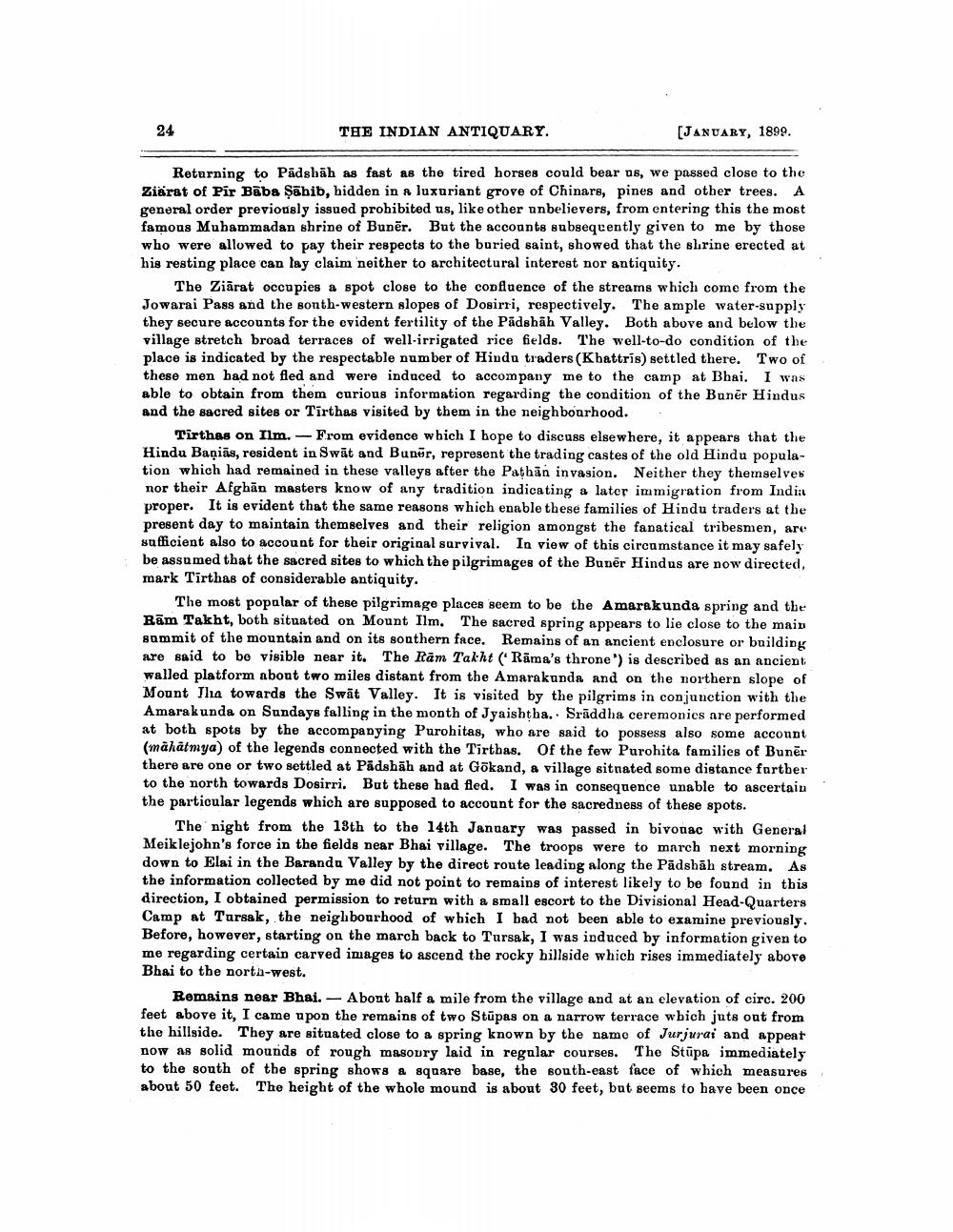________________
224
THE INDIAN ANTIQUARY.
(JANUARY, 1899.
Returning to Pädshāh as fast as the tired horses could bear us, we passed close to the Ziarat of Pir Baba Sabib, hidden in a luxuriant grove of Chinars, pines and other trees. A general order previously issued prohibited us, like other unbelievers, from entering this the most famous Muhammadan shrine of Bunēr. But the accounts subsequently given to me by those who were allowed to pay their respects to the buried saint, showed that the shrine erected at his resting place can lay claim neither to architectural interest nor antiquity.
The Ziarat occupies & spot close to the confluence of the streams which come from the Jowarai Pass and the sonth-western slopes of Dosirri, respectively. The ample water-supply they secure accounts for the evident fertility of the Pādshāh Valley. Both above and below the village stretch broad terraces of well-irrigated rice fields. The well-to-do condition of the place is indicated by the respectable number of Hindu traders (Khattris) settled there. Two of these men had not fled and were induced to accompany me to the camp at Bhai. I was able to obtain from them curious information regarding the condition of the Buner Hindus and the sacred sites or Tirthas visited by them in the neighbourhood.
Tirthas on Ilm. - From evidence which I hope to discuss elsewhere, it appears that the Hindu Baņias, resident in Swāt and Bunăr, represent the trading castes of the old Hindu population which had remained in these valleys after the Pathān invasion. Neither they themselves nor their Afghan masters know of any tradition indicating a later immigration from Indiit proper. It is evident that the same reasons which enable these families of Hindu traders at the present day to maintain themselves and their religion amongst the fanatical tribesmen, are sufficient also to account for their original survival. In view of this circumstance it may safely be assumed that the sacred sites to which the pilgrimages of the Buner Hindus are now directed, mark Tirthas of considerable antiquity.
The most popular of these pilgrimage places seem to be the Amarakunda spring and the Rām Takht, both situated on Mount Ilm. The sacred spring appears to lie close to the main summit of the mountain and on its southern face. Remains of an ancient enclosure or building are said to be visible near it. The Rām Takht ("Rāma's throne') is described as an ancient walled platform about two miles distant from the Amarakunda and on the northern slope of Mount Ilia towards the Swāt Valley. It is visited by the pilgrims in conjunction with the Amara kunda on Sundays falling in the month of Jyaishtha.. Srāddha ceremonies are performed at both spots by the accompanying Purohitas, who are said to possess also some account (mahatmya) of the legends connected with the Tirthas. Of the few Parohita families of Bunēr there are one or two settled at Pädshāh and at Gökand, a village sitnated some distance further to the north towards Dosirri. But these had fled. I was in consequence unable to ascertain the particular legends which are supposed to account for the sacredness of these spots.
The night from the 13th to the 14th January was passed in bivouac with General Meiklejohn's force in the fields near Bhai village. The troops were to march next morning down to Elai in the Barandu Valley by the direct route leading along the Pādshāh stream. As the information collected by me did not point to remains of interest likely to be found in this direction, I obtained permission to return with a small escort to the Divisional Head-Quarters Camp at Tursak, the neighbourhood of which I had not been able to examine previously. Before, however, starting on the march back to Tursak, I was induced by information given to me regarding certain carved images to ascend the rocky billside which rises immediately above Bhai to the north-west.
Remains near Bhai. - About half a mile from the village and at an elevation of circ. 200 feet above it, I came upon the remains of two Stūpas on a narrow terrace wbich juts out from the hillside. They are situated close to a spring known by the namo of Jurjurai and appeat now as solid mounds of rough masoury laid in regalar courses. The Stūpa immediately to the south of the spring shows a square base, the south-east face of which measures about 50 feet. The height of the whole mound is about 30 feet, but seems to have been once




